Navigation Bar - Navigation Bar in CSS
Navigation Bar - Navigation Bar , also known as menu bar, is used to navigate the main sections of a website, for example, on TipsMake.com there are some navigation such as "Home", "Technology village", " Technology "," Programming " . Navigation Bar is usually placed at the top of the web page or after the header, making the website clearer as well as making it easier for users to interact.
There are 2 most commonly used navigation types:
- Vertical Navigation - Vertical navigation bar.
- Horizontal Navigation - Horizontal navigation bar.

With CSS, you can make boring menu bars more beautiful.
Create navigation bar
There are many ways to create navigation, in this lesson TipsMake.com will work with you to learn how to create navigation using lists using tags
- and
- .
For example, you can create a list of elements as shown above:
- Home page
- Technology Village
- Technology
- Science
- Life
Result:

However, we should remove the index and margin, padding from the list:
ul {
list-style-type: none;
margin: 0;
padding: 0;
}

- Use list-style-type: none to remove the bullets because the navigation bar does not need this marker.
- Set margin: 0 padding: 0 to remove the default setting of the browser.
Full code like this:
- Home page
- Technology Village
- Technology
- Science
- Life
Note: This code is used for both horizontal and vertical navigation bars.
Vertical Navigation - Vertical navigation bar
To build a vertical navigation bar, you continue to format the element inside the list in the example above, adding the code below:
li a {
display: block;
width: 60px;
}
- display: block is used to display the link as a block element, so you can click anywhere in the block to open the link (not just click on the text as before).
- Can specify width, padding, margin . if desired.
Also, you can set the width of both
- and produce the same result as above:
ul {
list-style-type: none;
margin: 0;
padding: 0;
width: 60px;
}
li a {
display: block;
}
Example vertical navigation bar
Create a simple vertical navigation bar with a certain background color and change the background color of the path when the user hovers over it:
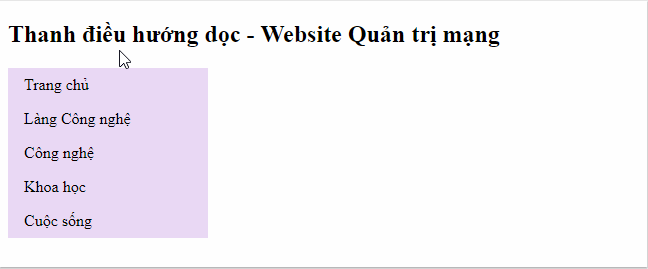
Vertical navigation bar - Website Network administration
- Home page
- Technology Village
- Technology
- Science
- Life
The current navigation path is active
Add 'active' to the current link so that users know what category they're currently viewing:
.active {
background-color: #58257b;
color: white;
}
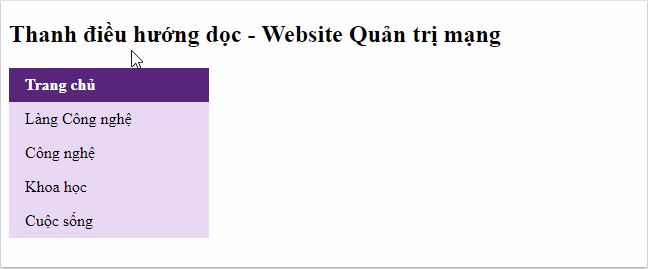
Vertical navigation bar - Website Network administration
- Home page
- Technology Village
- Technology
- Science
- Life
Align paths and add borders (border) for navigation
Add text-align: center in
- or to align the path to the center of the block.
Add the border attribute
- to surround the navigation bar. If you also want the border inside the navigation bar, add border-bottom to all elements
- except for the last card:
ul {
border: 1px solid #db7093;
}
li {
text-align: center;
border-bottom: 1px solid #db7093;
}
li:last-child {
border-bottom: none;
}
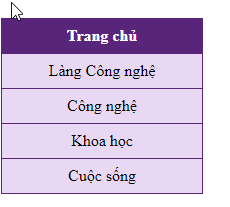
Vertical navigation bar - Website Network administration
- Home page
- Technology Village
- Technology
- Science
- Life
Fixed vertical navigation bar height
Create a navigation bar defining the height, fixed on the left:
ul {
list-style-type: none;
margin: 0;
padding: 0;
width: 25%;
background-color: #f1f1f1;
height: 100%; /* chiều cao 100% */
position: fixed; /* cố định thanh điều hướng cả khi cuộn để đọc website */
overflow: auto; /* nếu nội dung quá dài sẽ có thêm thanh cuộn để xem phần còn lại */
}
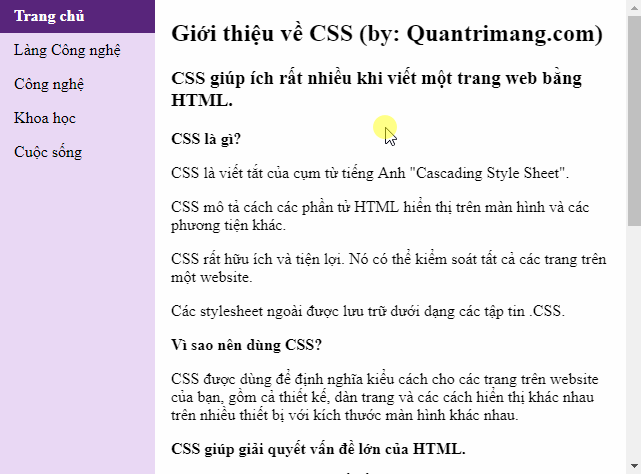
- Home page
- Technology Village
- Technology
- Science
- Life
Introduction to CSS (by: TipsMake.com)
CSS helps a lot when writing a website in HTML.
What is CSS?
CSS stands for English phrase "Cascading Style Sheet".
CSS describes how HTML elements display on screens and methods
Other convenience.
CSS is very useful and convenient. It can control all pages
on a website.
The external stylesheet is stored as .CSS files.
Why should CSS be used?
CSS is used to define styles for pages on the website
you, including the design, the layout and the different ways to display it
device with different screen sizes.
CSS helps solve big problems of HTML.
HTML does not have an element to format the web page. HTML only
used to create content for the site. When elements like and attribute
Colors are added to HTML 3.2, the nightmare of web developers
begin. Developing a large website that adds font or color information
sharpness on each page requires a lot of time.
To solve this problem, the World Wide Web Consortium (W3C) has created
CSS, eliminating style formatting from HTML pages. Definitions
related to the style that is included in the .css file and thanks to the file
External stylesheet, you can change the whole website with just one episode
Unique news.
Note :
- The div element has a margin-left left margin of 25% because the side navigation bar has a width of 25%. If not using margin-left, the navigation bar will overlap on this div.
- Use overflow: auto to add a scroll bar if the content is too long to see the rest.
- This example may not work correctly on a mobile device.
Horizontal Navigation - Horizontal navigation bar
There are 2 ways to create a horizontal navigation bar, that is to use a list inline or float .

Use Inline
Inline is a way to display elements on the same row. To create a horizontal navigation bar, you add the display: inline attribute to the element
- in the example create a navigation bar at the beginning of the article.
li {
display: inline;
}
By default,
- is a block element, we override display: inline, remove interrupts before and after each element, display only one line.
Use Float
Another way to create horizontal navigation bar is float elements
- and layout format for navigation links:
li {
float: left;
}
a {
display: block;
padding: 8px;
background-color: #e9d8f4;
}
- Use float: left so that the floating elements are side by side.
- The display: block attribute allows you to display links as block elements, so you can click anywhere in the block to open the link (not just click on the text as before), you can specify padding, height, width, margin . if desired.
- padding: 8px: block elements by default occupy the entire available width of the web page so that elements cannot float side by side. So, specify some padding to make them appear more neat.
- background-color: # e9d8f4: Add background color to each element (should be added
- instead of element).
- Home page
- Technology Village
- Technology
- Science
- Life
For example horizontal navigation bar
Create a simple horizontal navigation bar with a background color and change the background color of the path when the user hovers over it:

Horizontal navigation bar - Website Network administration
- Home page
- Technology Village
- Technology
- Science
- Life
The current navigation path is active
Add 'active' to the current link so that users know what category they're currently viewing:
.active {
background-color: #58257b;
color: white;
}

Align navigation link
You can push an element to the right of the screen according to the layout of the website using float: right
- Introduce
- Rules
- Contact
- Registration
Divide the navigation bar by border
Add a right border to all list items, except for the last item, to divide the navigation bar into clearer items.
li {
border-right: 1px solid #db7093;
}
li:last-child {
border-right: none;
}

Introduce
- Rules
- Contact
Registration
The navigation bar has border
ul {
border: 1px solid #d6b7eb;
background-color: #e9d8f4;
}
li a {
color: #black;
}

Fixed navigation bar
1. Use position: fixed
Fixed the navigation bar at the top or bottom of the page even when users use the scroll bar to move page content:
Fixed top side Fixed bottom side
ul {
position: fixed;
top: 0;
width: 100%;
}
ul {
position: fixed;
bottom: 0;
width: 100%;
}
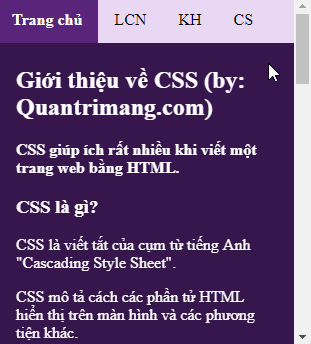

- Home page
- LCN
- Customer
- CS
Introduction to CSS (by: TipsMake.com)
CSS helps a lot when writing a website in HTML.
What is CSS?
CSS stands for English phrase "Cascading Style Sheet".
CSS describes how HTML elements display on screens and methods
Other convenience.
CSS is very useful and convenient. It can control all pages
on a website.
The external stylesheet is stored as .CSS files.
Why should CSS be used?
CSS is used to define styles for pages on the website
you, including the design, the layout and the different display ways
Many devices with different screen sizes.
CSS helps solve big problems of HTML.
HTML does not have an element to format the web page. HTML only
used to create content for the site. When elements like and attribute
Colors are added to HTML 3.2, the nightmare of web developers
begin.
To solve this problem, the World Wide Web Consortium (W3C) has created
CSS, eliminating style formatting from HTML pages.
2. Use position: sticky
Using this attribute, the original menu will still have a flexible position until a certain location and "stick" there.
ul {
position: -webkit-sticky; /* áp dụng với Safari */
position: sticky;
top: 0;
}

Website Administration Network
Knowledge - Experience - FAQ
- Home page
- Technology Village
- Technology
- Science
- Life
Introduction to CSS (by: TipsMake.com)
CSS helps a lot when writing a website in HTML.
What is CSS?
CSS stands for English phrase "Cascading Style Sheet".
CSS describes how HTML elements display on screens and methods
Other convenience.
CSS is very useful and convenient. It can control all pages
on a website.
The external stylesheet is stored as .CSS files.
Why should CSS be used?
CSS is used to define styles for pages on the website
you, including the design, the layout and the different display ways
Many devices with different screen sizes.
CSS helps solve big problems of HTML.
HTML does not have an element to format the web page. HTML only
used to create content for the site. When elements like and attribute
Colors are added to HTML 3.2, the nightmare of web developers
begin. Developing a large website that adds font or color information
sharpness on each page requires a lot of time.
To solve this problem, the World Wide Web Consortium (W3C) has created
CSS, eliminating style formatting from HTML pages
The meaning is related to the style that is included in the .css file and thanks to the file
External stylesheet information, you can change the entire website with just one
single file.
Previous article: Opacity / Transparency Properties in CSS
Next lesson: CSS Dropdown effect
You should read it
- Macromedia Flash - Create vertical Flash menu
- How to add items to the 'Create New' context menu in Windows 10
- How to use Open-Shell to create your own Start menu on Windows 10
- How to add a menu bar for iPhone
- FLOAT and CLEAR properties in CSS
- What is the Menu key? And how to remap it?
- How to fix the loss of the New menu in the right-click menu
- Google: Android users prefer to use 3 traditional navigation keys than 'inspired' gesture navigation from iOS
May be interested
- How to create iPhone X navigation bar on Android
 to bring the iphone navigation bar to android devices, we can install the navigation gestures application.
to bring the iphone navigation bar to android devices, we can install the navigation gestures application. - Instructions for creating websites with Dreamweaver CC - Part 6: Create links and navigation menus
 in the sixth part of this series, learn how to style menus and links, apply javascript to hide and display menus depending on the screen size.
in the sixth part of this series, learn how to style menus and links, apply javascript to hide and display menus depending on the screen size. - 5 applications to replace Google Maps in Vietnam
 some map applications replace google maps and still provide full navigation features, searching for address information.
some map applications replace google maps and still provide full navigation features, searching for address information. - How to switch the gesture navigation feature of Android Q back to the old button system
 when google launched beta versions of android q, it apparently copied a little something from the apple user interface.
when google launched beta versions of android q, it apparently copied a little something from the apple user interface. - How to reset the status to expand the File Explorer navigation pane on Windows 10
 this article will show you how to reset the expanded state of the navigation pane in file explorer to the default state on windows 10.
this article will show you how to reset the expanded state of the navigation pane in file explorer to the default state on windows 10. - Google Assistant has been integrated into Google Maps
 this new update of this extremely popular navigation application is for both ios and android users, enabling them to control voice navigation navigation.
this new update of this extremely popular navigation application is for both ios and android users, enabling them to control voice navigation navigation. - Automatically change the Android navigation bar according to the running application without root
 changing the navigation bar on android is a very interesting trick so you can choose the colors you love instead of having to use boring black on the previous device.
changing the navigation bar on android is a very interesting trick so you can choose the colors you love instead of having to use boring black on the previous device. - How to add a menu bar for iPhone
 to add iphone navigation bar or navigation bar, users can install windmill tweak with jailbreak device.
to add iphone navigation bar or navigation bar, users can install windmill tweak with jailbreak device. - Successful fabrication of quantum compass to atomic level, replacing GPS in the future
 scientists at the royal university of london have created a new navigation device that does not need a satellite, a quantum compass scientifically named independent quantum accelerometer - standalone quantum accelerometer.
scientists at the royal university of london have created a new navigation device that does not need a satellite, a quantum compass scientifically named independent quantum accelerometer - standalone quantum accelerometer. - These GPS applications do not need the best Internet connection for Android
 there are many navigation and gps applications for android on play store, but not all maps can be used without connecting to intnet. this article will provide you with the best 4 offline gps applications for android.
there are many navigation and gps applications for android on play store, but not all maps can be used without connecting to intnet. this article will provide you with the best 4 offline gps applications for android.










 Use Dropdown in CSS
Use Dropdown in CSS Image library in CSS
Image library in CSS Attribute Selector - Attribute Selector in CSS
Attribute Selector - Attribute Selector in CSS Form - Form in CSS
Form - Form in CSS Counter - Counter in CSS
Counter - Counter in CSS